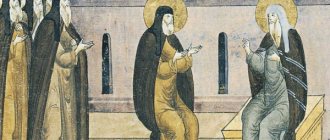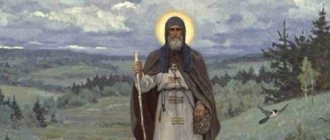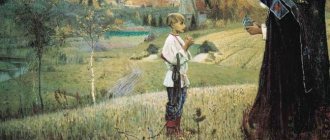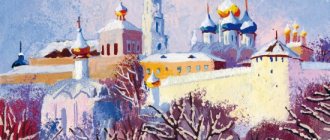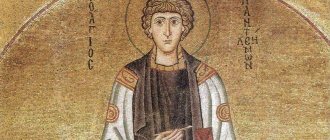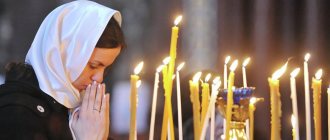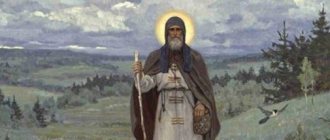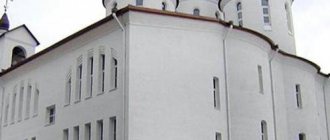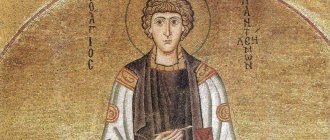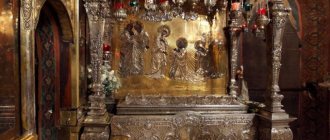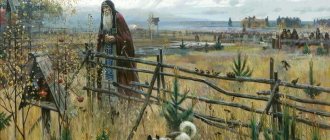Some facts from the biography
Sergius of Radonezh is rightfully revered by Orthodox Christians. During his lifetime he was a hieromonk and founded many monasteries. At birth he received the name Bartholomew, lived an interesting and long-suffering life, overcame all difficulties with faith in the Lord God.
The princes took his opinion into account, and the common people believed in the miracles he performed and revered him. After his death, St. Sergius was recognized as a Saint by the love of the people. The life path of the hieromonk is known from the work of his devoted disciple, Epiphanius the Wise, entitled “The Life of Sergius of Radonezh.” The hagiographer described the life path of St. Sergius, using many sources, including the stories of the hieromonk’s brother.
Childhood
The exact date of birth of the holy hieromonk is unknown. There are several approximate ones: 1314, 1319 and 1322. Many historians are inclined to the earliest date of his birth, based on the fact that Sergius became abbot of the Trinity-Sergius Monastery in 1344. A person could receive such spiritual rank only upon reaching a more mature age.
The future abbot was born into the family of boyar Kirill and his wife Maria. Place of birth - the village of Varnitsy, not far from Rostov. On the site of his parents' estate, the Trinity Varnitsky Monastery was built. In the church, the future hieromonk received the name Bartholomew at baptism. In addition to him, there were 2 more children in the family - brothers Stefan and Peter.
After 7 years, Bartholomew was sent to Rostov to study at a religious school. Grecophilism dominated among the clergy at that time. Rostov was the center of religious and cultural life of Rus'. In educational institutions, children were taught the Greek language and the Holy Scriptures written in Greek.
However, teaching was given to Bartholomew with great difficulty. The boy fervently prayed to the Lord and begged him to help with science. One day, under a tree, the boy saw a praying old man. Bartholomew told the old man about his problems with his studies and asked him to ask the Almighty for help.
The old man treated the boy to prosphora and predicted that from now on he would know how to read and write much better than his peers and siblings. The painter Nesterov painted the painting “Vision to the Youth Bartholomew”, based on this fact from the biography of Sergius.
After meeting the elder, Bartholomew began to study diligently and memorized the Holy Scriptures. While studying in Rostov, Bartholomew studied Greek and could read holy literature freely. The boy devoted a lot of time to prayer. From the age of 12 he observed strict fasting, fasted on Wednesdays and Fridays, and on other days he lived on water and bread. This behavior worried the mother.
In the 30s of the 14th century, the family of the future hieromonk became greatly impoverished; parents and children had to move to Radonezh, to a village on the edge of the Moscow principality. In those distant years, the Golden Horde dominated in Rus'. The Tatar hordes ravaged the population, the princes imposed an unbearable, huge tribute on their subjects, lawlessness, murders, and robberies reigned all around. By that time, Sergius of Radonezh had completely completed his studies in Rostov.
Monasticism
As a teenager, Bartholomew decided to become a monk. However, the parents wanted their son to live with them until their death, since other sons got married, and someone had to look after their father and mother. Soon the parents died, although shortly before their death, according to tradition, they took monasticism.
After the death of his father and mother, the future hieromonk went to the Khotkovo-Pokrovsky Monastery, where his elder brother Stefan prayed and lived righteously. He became a widower, which is why he became a monk. Bartholomew persuaded Stefan to leave the monastery and go to the bank of the Konchura River, in the Makovets tract. Far from people, in the thicket of the forest, the brothers built a modest cell, then built a small church and consecrated it in honor of the Holy Trinity.
After a while, Stefan went to Moscow, to the Epiphany Monastery. Bartholomew became a monk, began to be called Father Sergius, and remained to live in that tract alone. Soon monks from all over the area came to Makovets. In that deserted place, the monks founded a monastery - the Trinity-Sergius Lavra. True, Mitrofan was chosen as the first abbot, who tonsured Bartholomew as a monk. Father Sergius was appointed second hieromonk.
The monks lived by their own labors and did not take any alms from the believers. The community grew every year. Simple peasants settled around the new monastery, they built houses and developed fields. Soon the wilderness was transformed and turned into a populous settlement.
The existence of the new monastery was learned in Constantinople. Ecumenical Patriarch Philotheus sent Father Sergius a cross, a schema, a charter, and a paraman. The monastery decided to introduce konovia - a new rule of community life. All monks had to eat from a common cauldron, wear the same clothes and shoes, and obey the abbot.
The monastery was turned into a community living according to strict rules, whose residents prayed and worked in the fields themselves. According to information from the Life, not all monks were happy with the innovations. Due to the conflict in the monastery, Sergius left the monastery and soon founded a new Annunciation Monastery on the Kirzhach River.
Battle of Kulikovo
Father Sergius was considered a great peacemaker. The hieromonk knew how to reconcile the warring parties, with wise speeches he found a way to anyone, even the most callous heart. Father Sergius reconciled the warring princes, called on them to submit to the Moscow prince, unite the Russian lands into a single power and all together liberate Rus' from the Tatars.
Sergei of Radonezh blessed Prince Dmitry Donskoy for the battle with the Tatar horde. The Horde troops instilled fear in the Russian soldiers, who did not dare to fight with them. Father Sergius predicted Prince Dmitry victory over the troops of Khan Mamai. He also sent two of his monks to war, thereby violating church rules prohibiting monks from fighting.
The Russian army defeated the Tatars in the Battle of Kulikovo. The battle took place on the day of the Nativity of the Immaculate Mother of God. The victory over the Tatars became evidence of the patronage of the Mother of God herself to Russian soldiers. Since then, Father Sergius began to pray to the Virgin Mary daily.
Monasteries he founded
During his long and righteous life, Father Sergius founded many monasteries. The first were Troitsky and Blagoveshchensky. Then - Staro-Golutvin near Kolomna, Vysotsky in Serpukhov, Georgievsky on the Klyazma River. The Venerable Elder appointed his disciples as abbots of the monasteries.
Subsequently, Sergius' students founded 40 more monasteries. Most of the temples were built in the forest. Then peasant settlements appeared around them. With the help of the construction of monasteries, the development of Russian lands in the Volga region and northern regions took place.
Miracles
According to the stories of Epiphanius the Wise, there were many miracles in the life of Father Sergius. Even before he was born, the baby screamed in his mother’s womb as she prayed in church on Sunday. The fact that a boy mastered literacy after meeting the elder is also considered a miracle. True, historians believe that it was a vision.
Father Sergius had a special gift - he could predict the future, he was often visited by visions. One day, during the hour of prayer late in the evening, the monastery was illuminated by a dazzling light, and many birds flew in. The voice said that Sergius would have as many students and followers as he saw in that vision of birds. Another time, during the hour of prayer, Sergius saw the Mother of God surrounded by two apostles. The Virgin Mary said that she had heard the hieromonk’s prayers and would help him.
During his lifetime, Father Sergius was called a miracle worker. Somehow he found a source of water on the monastery territory. Another time he resurrected a dead boy when his father, having lost hope of salvation, went to fetch the coffin. Sergius treated insomnia, cast out demons, and restored sight. Even after death, the holy elder appeared in dreams, telling Christians how to defeat the enemy.
Death
Sergius of Radonezh lived to a ripe old age through labors, abstinence and prayers. The hieromonk was revered by disciples, believers and Russian princes. Anticipating his imminent death, Father Sergius gathered his brothers in faith, read instructions to them and appointed Nikon as abbot in his place.
Sergius of Radonezh bequeathed to Christians to have the fear of God, to maintain spiritual and physical purity, to take care of the Fatherland, to help the weak and poor.
The Reverend died in the fall of September 25, 1392, at the age of 70-78 years. The abbot bequeathed to bury himself in the monastery cemetery. However, the brethren decided to lay his holy body in the church. True, 16 years after his death the temple was looted and burned by the Tatars.
Soon the monks returned to their original place and began to restore the monastery. Father Sergius appeared in a dream to a layman. The hieromonk asked to move his relics to a safe place. During the construction of the stone Holy Trinity Cathedral in 1422, the remains of Sergius were raised from the flooded grave and transferred to the church. To this day, his holy relics are kept in a silver casket in the Trinity-Sergius Lavra.
Memory
Father Sergius was canonized by the people's love back in 1452, long before the official canonization procedure. Christians turn to him with prayers. The reverend hieromonk helps in teaching, coping with a serious illness, getting rid of addictions, pride, and vanity. The church honors Father Sergius on the day of his death, September 25 (October 8), and on the day of the discovery of his relics, July 5 (18).
Venerable Sergius: the transformation of monasticism
Before St. Sergius, Northern Russian monasticism knew mainly special monasteries. There, every monk had his own cell, dressed and ate as his personal income allowed. The communal principle in such monasteries took on a weakened, “blurred” appearance. Often such a monastery became a haven for pious aristocrats who lived out their lives here or spent time in exile, sometimes basking in luxury and leading a familiar life, very far from the monastic ideal. Since the time of Sergius, dramatic changes began in the monastic environment. Cenobitic, or, in other words, cenobial, monasteries began to appear everywhere. There, property, even books and small household items, became common, and meals became shared. The community spirit has gained a powerful impetus for development. In addition, the cinenial monastery could conduct a complex, progressive economy: land and other lands were willingly donated to it, and the income from them went to temple construction, charity and the needs of spiritual enlightenment. The cenobitic monastery often turned out to be a center of book writing and church painting. Meanwhile, none of the monks could appropriate for themselves all the material benefits that came from such a way of life.
In addition, the activities of St. Sergius and St. Alexy, Metropolitan of Moscow, opened the gates for an entire era of large-scale monastic colonization of the Russian outskirts. The disciples of Sergius and the disciples of his disciples went into the wilds of the forest, to the Arctic shores, to remote and deserted places, they set up new and new monasteries there, and settlements, fortresses and entire towns grew to these monasteries. The movement of monks looking for a place for solitary prayer and selfless dedication to God was very significant. It represents a page not so much even in Russian as in the world history of Christianity.
Description and meaning of the icon
Sergius of Radonezh is the most revered saint in Orthodoxy. His first image was made on a sewn cover back in the 20s of the 15th century. In those days, his image was painted on liturgical utensils. In subsequent years, the Venerable Elder was depicted on hagiographic icons. In the center of such images a saint was drawn, and in the margins, in the stamps, there were scenes from his life.
There are icons with 19 and 17 marks, each of which tells about the miracles and deeds of the hieromonk.
Usually Sergius of Radonezh is depicted as a gray-bearded old man with a scroll in his left hand, while his right hand is raised for blessing. Such an image means that the saint understands the sinfulness of man and asks everyone to repent of their sins. Sergius devoted his entire life to monasticism and the unity of the Russian lands. His icon recalls the feat of the saint, and Father Sergius himself is an example of integrity, faith in God, patience and meekness.
Repose of Abbot Sergius
At the end of his righteous life, Sergius, having perspicaciously learned about his impending death six months before, called the brethren to him and, after a brief council of the elders, indicated that the student Nikon (1352-1426), experienced in spiritual life and obedience, should be chosen as rector. Just before his death, the abbot of the Russian land called the brethren to his deathbed and addressed the words of his will:
Take heed, brothers. First have the fear of God, spiritual purity and unfeigned love...
St. Sergius says goodbye to the brethren of the monastery.
Miniature of the Front Life of St. Sergius. Moscow. End of the 16th century Moscow, Russian State Library On September 25 (old style), 1392, the Monk Sergius reposed. Church historian E.E. Golubinsky wrote that Sergius ordered his body to be laid not in the church, but in the general monastery cemetery. This command greatly upset the brethren. The monks turned for advice to Metropolitan Cyprian, who said to lay the body of Abbot Sergius in the church.
What do they pray to the saint for?
Believers consider Father Sergius a miracle worker and a saint. In their prayers, they ask the Reverend Elder to help them in worldly affairs, protect them from evil influences, and heal their body and soul.
Studies
Father Sergius helps with studies, before sessions and exams. The saint hears the prayers of everyone who prays and turns to him. You need to say in front of the icon: “Reverend Father Sergius, pray to God for me!” Before exams, it is advisable to go to church, pray and light a candle to the saint.
Litigation
Believers turn to the saint on the eve of trials. During his lifetime, Father Sergius stood up for the weak and helped them in the struggle for justice. Prayer to his divine face gives self-confidence to all who fight for the truth in the courts.
Quieting Pride
St. Sergius can help in prayers for the granting of humility and the taming of pride. When turning to the Reverend Elder, you need to repent of your sins and ask him to pray before God for your sinful soul.
Healing
Mothers turn to the Reverend Elder and ask him to heal the child. The saint is a mediator between people and the Almighty. Orthodox believe in the intercession of Sergius. Christians pray to him and ask him to grant health to themselves, their children, and their loved ones.
Protection
Prayer to Saint Sergius protects the house from enemies, and the soul from evil thoughts and passions. The elder served his native Fatherland all his life, strengthened the princes’ faith in God before battles, and sent monks to defend the land and fight the Tatars. Sergius always trusted in God’s help and received it in difficult times. His life is an example for all Christians.
Job
Sergius of Radonezh worked all his life. Believers turn to him so that in prayers to the Lord the holy elder will help them overcome life's difficulties. Sergius gives Christians faith in their own strength, encourages them not to be afraid of any work, and helps them get a new job.
Peace of mind
Fervent prayer to the holy elder helps to get rid of sinful thoughts, calm the soul, and find peace of mind. Sergius of Radonezh believed that faith in the Lord God and observance of his commandments help to live a righteous life and not sin. He taught his students humility and tolerance. Believers turn their requests to the Reverend Elder in the most anxious days of their lives.
Troparion, kontakion and canon to St. Sergius of Radonezh
Troparion, tone 4.
He who is an ascetic of virtue, as if he were truly a warrior of Christ God, labored on great passions, towards the temporal life, in singing, vigils and fasting, being the image of his disciple. This is how the Most Holy Spirit dwells in you, and is brightly adorned by its action. But since you have boldness towards the Holy Trinity, remember the flock wisely, and do not forget what you promised when visiting your children, Our Reverend Sergius.
Kontakion, tone 8.
Having been wounded by the love of Christ, the venerable one, and following that irrevocable desire, you hated all carnal pleasures, and like the sun you shone for your Fatherland. With this Christ enriched you with the gift of miracles. Remember us who honor your blessed memory, and we call you, rejoicing to Sergius, God-wise.
Library of the Russian Faith Canon to St. Sergius of Radonezh →
Read online
How to pray correctly
Believers must pray. It is better to read ready-made prayers written by saints. Such people have been praying alone for decades; they know what to ask the Lord God for. After all, prayer is not a desire that believers ask the Almighty to fulfill, but repentance of their own sins, a request for help and guidance on the true path.
St. Ephraim the Syrian said that people do not know what to pray for, they do not know what is useful for them, what they need to ask God for in prayers. The Almighty already knows all the problems of Christians. He will help save a sinful soul if a person repents of his sins and reads prayers written by holy people.
Old Believer churches in the name of St. Sergius of Radonezh
Before the revolution, there were two Old Believer churches in the name of St. Sergius of Radonezh : a temple in the village of Dmitrovo, Pogorelsky district, Kalinin region (now Zubtsovsky district, Tver region) and a temple in the village of Matyukovo (Torzhoksky district, Tver region). Both temples were destroyed during the atheistic years. In the Old Believers, there are currently several churches in the name of St. Sergius of Radonezh the Wonderworker. In the Russian Orthodox Old Believer Church, today is a temple holiday in the city of Sychevka, Smolensk region and in the village. Mikvarovo, Kirov region. In the name of the saint, the boundary of the Cathedral of the Intercession of the Most Holy Theotokos on Rogozhsky was also consecrated. In the Russian Ancient Orthodox Church, churches in the village were consecrated in the name of Sergius of Radonezh. Chaplygino, Kursk region and Orsk, Orenburg region. Also in honor of the saint, a church of the same faith was consecrated in the village of Pavlovo-on-Neva, Leningrad region.
Church in the name of St. Sergius of Radonezh the Wonderworker in the city of Sychevka, Smolensk region
In the name of St. Sergius, the lower church of the famous Old Believer Assumption Church on Apukhtinka was also consecrated (now there is a dormitory in the temple building).
Assumption Cathedral on Apukhtinka (now a hostel)
Examples of Prayer
You need to ask Sergius of Radonezh for help and intercession by reading prayers according to the prayer book. Only such speeches are heard by the hieromonk and the Lord God.
About adding intelligence
In this prayer St. Father Sergius is asked to hear the requests addressed to him and to convey them to the Most Immaculate Mother of God herself. After all, after death the saint approached the Heavenly Powers. Believers assure Father Sergius of their love for God and worship of his holy relics. They ask for help in overcoming the granite of science, adding intelligence, removing the scales from the eyes and opening the mind to the truth.
Before the exam
In this appeal to Father Sergius, believers ask him to lead them to heavenly heights. Christians pray to deliver them from cowardice, to confirm them in faith and devotion to God. Believers ask St. Sergius to pray on their behalf to the Most High. Christians believe in the intercession of the saint at the Last Judgment and repent of their sins.
Defense of the Fatherland from Infidels
In this prayer, believers ask the Saint to pay attention to them, to look down from the heights of heaven at sinful people. Christians will assure Father Sergius of his love for God, asking him to enlighten them in days of difficult trials, to give them strength and courage to withstand the battle with their enemies.
Troparion
This song says that from early youth, Father Sergius loved the Almighty with all his soul. He retired from the bustle of the world, went into the distant desert to pray to the Lord God and live according to his laws. Father Sergius founded a monastery in which he prayed to the Savior for sinful souls. People came to him from everywhere for faith and healing, he helped everyone find peace of mind and strengthen their faith in God.
First
In this prayer, believers turn to Father Sergius, calling him Holy, Reverend, God-Bearing. Christians believe in his ascension to heaven after death and that he communicates with the Mother of God herself. Believers ask them to love, to pray for the salvation of their sinful souls, to intercede for them before the Almighty and the Virgin Mary.
Second
Christians make this request to Father Sergius. They ask him not to forget the unfortunate, to remember them in his prayers to the Almighty. Believers assure Father Sergius of love and respect. They ask to convey their prayers to the Lord God himself, not to remain silent about their requests and to pray for the salvation of sinful souls.
Third
In this petition Rev. Father Sergius is asked to graciously look down from heavenly heights and see all those asking. Believers understand that they are far from the holy elder, not only in the literal, but also in the figurative sense. After all, they are sinners, so they ask to bring them to reason, to guide them on the true path, to convey their prayers to the Lord God himself, to forgive their sins and not to abandon them in difficult times.
Miracles of Sergius of Radonezh
As indicated in the Life, Sergius of Radonezh performed many miracles. People came to him from different villages, hamlets and cities to receive spiritual advice, and sometimes even just to see him. As the hagiographers of Sergius write, he often healed the suffering, and once he resurrected a boy who died in his father’s arms when he was carrying the child to the abbot. The fame of Sergius' miracles quickly spread throughout Rus'. Sick people from different areas began to come to him. And none of them left without good advice and healing. But human glory weighed heavily on the ascetic. One day, Bishop Stefan of Perm (about 1330-1340 - 1396) was heading from his diocese to Moscow. The road ran not far from the Sergius Monastery. The bishop decided to visit the monastery on the way back and stopped, read a prayer, bowed to Abbot Sergius with the words “Peace be with you, spiritual brother.” At this time, Sergius was at a meal with the brethren. In response to Bishop Stephen, Sergius sent a blessing. Some of the disciples were very surprised by the abbot’s act and hurried to the indicated place, where they saw Bishop Stephen.
Saint Stephen of Perm with his life. Icon. Rus. 1st half of the 17th century From the St. Nicholas Church of the Solvychegda Holy Cross Monastery, Arkhangelsk Region
Once, during the liturgy, an Angel of the Lord concelebrated with St. Sergius, but in his humility, the abbot forbade anyone to tell about this until the end of his earthly life. For his pious life, Sergius was awarded heavenly vision from the Lord. Once he prayed in front of the icon of the Mother of God and, having finished the prayer, sat down to rest. And suddenly he told his disciple Micah that a miraculous visit awaited them. A moment later, the Most Holy Theotokos appeared, accompanied by the holy apostles Peter and John the Theologian. From the unusually bright light, the abbot fell to the ground, but the Mother of God touched him with her hands and, blessing him, promised to always patronize his monastery.
Where are the icons located?
The Venerable Father Sergius is depicted on single and hagiographic icons. He was often depicted at full length in a cassock, because he was a monk all his life. In the hagiographic icons, artists painted an image of Father Sergius in the center, and about 17-20 scenes from his life along the edges. In each mark you can see what the hieromonk did - he healed the sick, prayed, blessed the soldiers for victory.
In the Holy Trinity Lavra of Sergius in the Moscow region, in Sergiev Posad, there are the relics of the saint. The remains and holy icon of the hieromonk are available in the courtyard of the Trinity-Sergius Lavra in the Church of the Life-Giving Trinity, as well as in the Church of St. Nicholas in Klenniki, in the Moscow Church of Elijah the Obydeniy. In the village of Bibirevo, in the Church of St. Sergius, there is an ancient icon that commemorates salvation from cholera in the 19th century. The collection of the Andrei Rublev Museum contains an icon of the hieromonk with 17 marks of his life. An image of the saint is found in almost every church.
The image of Sergius of Radonezh in painting
In addition to the icons of St. Sergius of Radonezh, there are also paintings that depict events from the life of the Radonezh abbot. Among Soviet artists one can single out M. V. Nesterov . The following of his works are known: “The Works of Sergius of Radonezh”, “The Youth of Sergius”, “Vision to the Youth Bartholomew”. Also among the artists who turned to the image of Sergius of Radonezh were V. M. Vasnetsov (the image of St. Sergius for the temple in Abramtsevo), E. E. Lisser (“Sergius of Radonezh blessing Dmitry Donskoy before the Battle of Kulikovo”), N. K. Roerich (“St. Sergius of Radonezh”) and others.
M. V. Nesterov. Appearance to the youth Bartholomew
M. V. Nesterov. Works of Sergius of Radonezh, triptych
N.K. Roerich. "St. Sergius of Radonezh", 1932
When an icon is venerated
The memory of the life of the Reverend is alive to this day. The saint is remembered by the clergy, because thanks to him many monasteries were opened in Russian lands. Father Sergius contributed to the strengthening of Orthodoxy in Rus'. The Church remembers the hieromonk twice every year. The first time was in the summer on July 18, on the day of the discovery of his relics. The holiday is dedicated to the removal of remains from a flooded grave and their transfer to a safe place in a new church. Since the 15th century, Orthodox Christians have celebrated the death of the abbot every year on October 8th. On memorial days, a festive service is held in churches in honor of St. Sergius. The clergy and believers sing the troparion to the hieromonk.
During his lifetime, Father Sergius was very wise, kind, and educated. He advocated the unification of Rus', called on the princes not to fight each other, but to unite and oppose the Tatars. Sergius blessed believers with family happiness, love and fidelity. Lonely people turn their prayers to him, he helps them find their soul mate and happiness.
An icon depicting a saint should be in every home. It helps you become more tolerant, kinder, smarter. True, to find happiness and peace of mind, you need to repent of all your sins, sincerely ask God to save your sinful soul and put you on the right path.
Peacemaking of Sergius of Radonezh
Another aspect of Abbot Sergius’s activity was peacemaking. With wise and meek words, he influenced the most hardened and embittered hearts, very often reconciling the warring princes, persuading them to obey the Grand Duke of Moscow (for example, the Rostov prince in 1356, the Nizhny Novgorod prince in 1365, Oleg of Ryazan, etc. ). At that time, Rus' was tormented by the Mongol-Tatar yoke. Grand Duke Dimitri Ioannovich Donskoy (1350-1389) gathered an army and came to the monastery of Sergius to ask for his blessing for the upcoming battle, which later went down in history as the Battle of Kulikovo. As assistants to the Grand Duke, Sergius blessed two monks of his monastery - schemamonks Andrei (Oslyabya) and Alexander (Peresvet) , predicting victory for Prince Dimitri. And this time the words of the abbot of the Trinity monastery were fulfilled: on September 8 (Old Art.), 1380, on the day of the Nativity of the Blessed Virgin Mary, Russian soldiers defeated the Tatar hordes on the Kulikovo field, thereby marking the beginning of the liberation of the Russian land from the Mongol-Tatar yoke. During this massacre, Sergius and the brethren of the Trinity Monastery prayed to God to grant victory to the Russian prince and his army.
Trinity-Sergius Lavra. Photochrome (color lithograph), 1890s
In 1382, when Tokhtamysh’s army approached Moscow, Sergius left his monastery and went to defend Prince Mikhail Alexandrovich of Tver (1333-1399).
After repelling the invasion of Khan Mamai, the Moscow prince began to treat the Radonezh abbot with even greater reverence and invited him in 1389 to seal a spiritual will legitimizing the new order of succession to the throne from father to eldest son.
Library of the Russian Faith Teaching in memory of St. Sergius of Radonezh. Great Menaion of Cheti →
Read online in original
